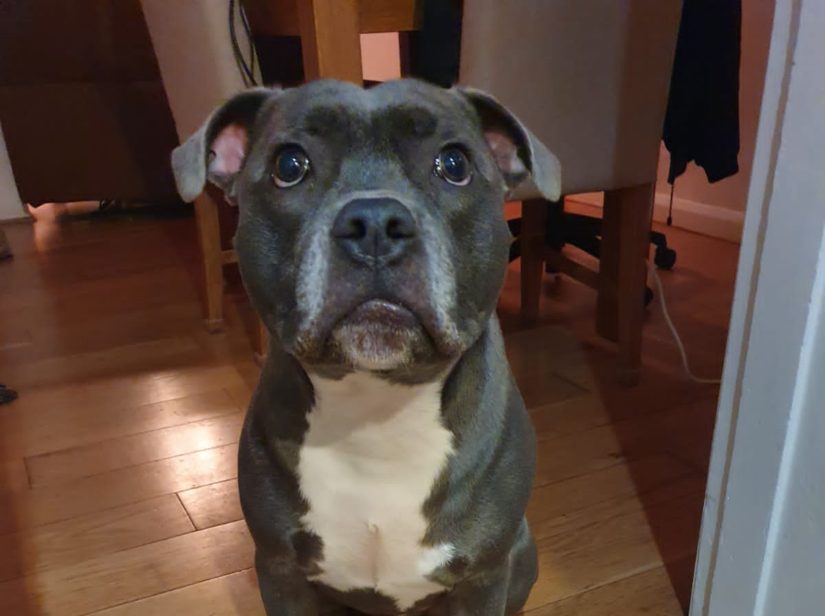
Ralf is a young, lively, playful but incredibly friendly Staffordshire Bull Terrier. He had been suffering with intermittent lameness for a while and his owners were concerned about this. They took him to his vet who said that Ralf had excessively licked one of his paws and there were signs of inflamed skin under the pad. His owners were not convinced that this was the issue so contacted me to assess him.
When I met Ralf I was taken aback at the size of him, such a big boy, but what a gentle giant with a wonderful friendly demeanour he is, albeit he is a real live wire who struggled to sit still as he just wanted to climb on me and lick me to death.

I immediately noticed that Ralf lives in a house with wooden floors. This is the number 1 cause for dog injuries in the home. Dogs are phalangeal creatures which means they walk on their toes and they need to grip the ground with their claws to gain purchase. Wooden, tiled or laminate floors are therefore very slippery and incredibly challenging for dogs to walk on or even get up from laying down. It’s a bit like a human trying to walk across an ice rink, it wouldn’t end well. I therefore advised Ralf’s owners that it would be in his best interests to buy some non slip runners or mats for the downstairs area, especially at the bottom of the stairs which is particularly dangerous as dogs often come charging down the stairs at a rate of knots and are unable to stop at the bottom.
I went on to assess Ralf’s gait (the way he walks) where it was apparent he had right fore limb lameness as he walked, and stiffness in his hind limbs on rising and lowering. I continued with a palpation routine which involves me feeling the muscles around his body to assess where he may have any issues such as a strain, trigger point (knot of tension) or any Myofascial pain in his muscles or tissues. I discovered some pain along his back muscles in the lumbar area above the pelvis and across the shoulder area, a hypertonic (hard) muscle in the left side of his neck which is unsurprising considering the size and thickness of his neck and again a hypertonic Gracilis muscle on his left hind limb, which is the muscle in the dog’s hind limb that allows him to accelerate.

Actually getting Ralf to relax in order for me to treat him was very challenging, he was so excitable and playful he just wanted to climb on me and lick me and of course get to the treats I had in my bag. With the help of his owner I was able to adapt the treatment and work on Ralf as best I could in the circumstances, massaging and performing particular muscle releases on the main muscle groups around his body and concentrating on the areas I had picked up on that had issues. As a result of working these particular areas it can appear that we can make the issue worse before it is resolved. By working on the shoulder area Ralf’s limp immediately became even more apparent after each session.

I am delighted that Ralf’s owners also took on board my advice regarding the flooring issue and purchased non stick rugs to reduce any risk of further injury. Without doing this, even with the massage treatments the issue can and usually will return if the home is not adapted to suit the dogs needs. This is why it is very important that as a massage therapist I ask questions regarding the dogs activities of daily living i.e. is their dog very lively, does he regularly jump on and off sofas, run up and down stairs, or chase balls or sticks. These things are all relevant to be able to assess any risk of injury to the dog.

Most issues or injuries are able to be resolved or improved with 3 sessions provided at an interval of no more than 7 to 10 days between. It took all 3 sessions in order to provide a good result for Ralf. Each week saw some improvement but I was delighted to say that following all 3 sessions Ralf messaged me personally after a trip to the seaside thanking me for helping him get better, allowing him to go for longer walks with his dad and to be able to run freely round the park again with no limping or lameness. Yes, he is a very clever boy indeed. What can I say, I love my job!!
If your dog is struggling with any form of lameness then get in touch with me to book a treatment:
viv@northantscaninemassagetherapyclinic.co.uk




